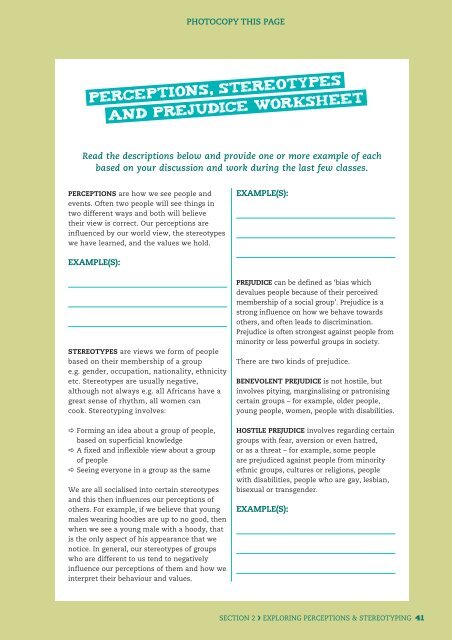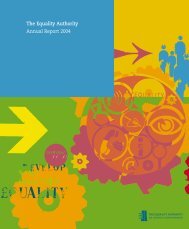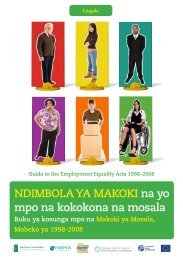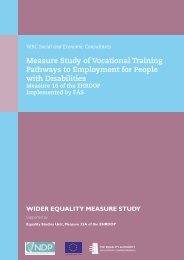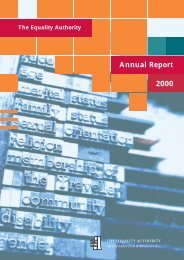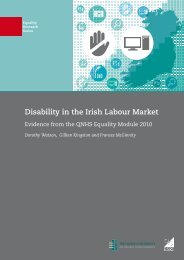Equality and Diversity - Building a Culture of ... - Equality Authority
Equality and Diversity - Building a Culture of ... - Equality Authority
Equality and Diversity - Building a Culture of ... - Equality Authority
You also want an ePaper? Increase the reach of your titles
YUMPU automatically turns print PDFs into web optimized ePapers that Google loves.
PHOTOCOPY this page<br />
Perceptions, Stereotypes<br />
<strong>and</strong> Prejudice Worksheet<br />
Read the descriptions below <strong>and</strong> provide one or more example <strong>of</strong> each<br />
based on your discussion <strong>and</strong> work during the last few classes.<br />
Perceptions are how we see people <strong>and</strong><br />
events. Often two people will see things in<br />
two different ways <strong>and</strong> both will believe<br />
their view is correct. Our perceptions are<br />
influenced by our world view, the stereotypes<br />
we have learned, <strong>and</strong> the values we hold.<br />
Example(S):<br />
Example(S):<br />
Stereotypes are views we form <strong>of</strong> people<br />
based on their membership <strong>of</strong> a group<br />
e.g. gender, occupation, nationality, ethnicity<br />
etc. Stereotypes are usually negative,<br />
although not always e.g. all Africans have a<br />
great sense <strong>of</strong> rhythm, all women can<br />
cook. Stereotyping involves:<br />
Forming an idea about a group <strong>of</strong> people,<br />
based on superficial knowledge<br />
A fixed <strong>and</strong> inflexible view about a group<br />
<strong>of</strong> people<br />
Seeing everyone in a group as the same<br />
We are all socialised into certain stereotypes<br />
<strong>and</strong> this then influences our perceptions <strong>of</strong><br />
others. For example, if we believe that young<br />
males wearing hoodies are up to no good, then<br />
when we see a young male with a hoody, that<br />
is the only aspect <strong>of</strong> his appearance that we<br />
notice. In general, our stereotypes <strong>of</strong> groups<br />
who are different to us tend to negatively<br />
influence our perceptions <strong>of</strong> them <strong>and</strong> how we<br />
interpret their behaviour <strong>and</strong> values.<br />
Prejudice can be defined as ‘bias which<br />
devalues people because <strong>of</strong> their perceived<br />
membership <strong>of</strong> a social group’. Prejudice is a<br />
strong influence on how we behave towards<br />
others, <strong>and</strong> <strong>of</strong>ten leads to discrimination.<br />
Prejudice is <strong>of</strong>ten strongest against people from<br />
minority or less powerful groups in society.<br />
There are two kinds <strong>of</strong> prejudice.<br />
Benevolent prejudice is not hostile, but<br />
involves pitying, marginalising or patronising<br />
certain groups – for example, older people,<br />
young people, women, people with disabilities.<br />
Hostile prejudice involves regarding certain<br />
groups with fear, aversion or even hatred,<br />
or as a threat – for example, some people<br />
are prejudiced against people from minority<br />
ethnic groups, cultures or religions, people<br />
with disabilities, people who are gay, lesbian,<br />
bisexual or transgender.<br />
Example(S):<br />
sECTION 2 Exploring Perceptions & Stereotyping 41


